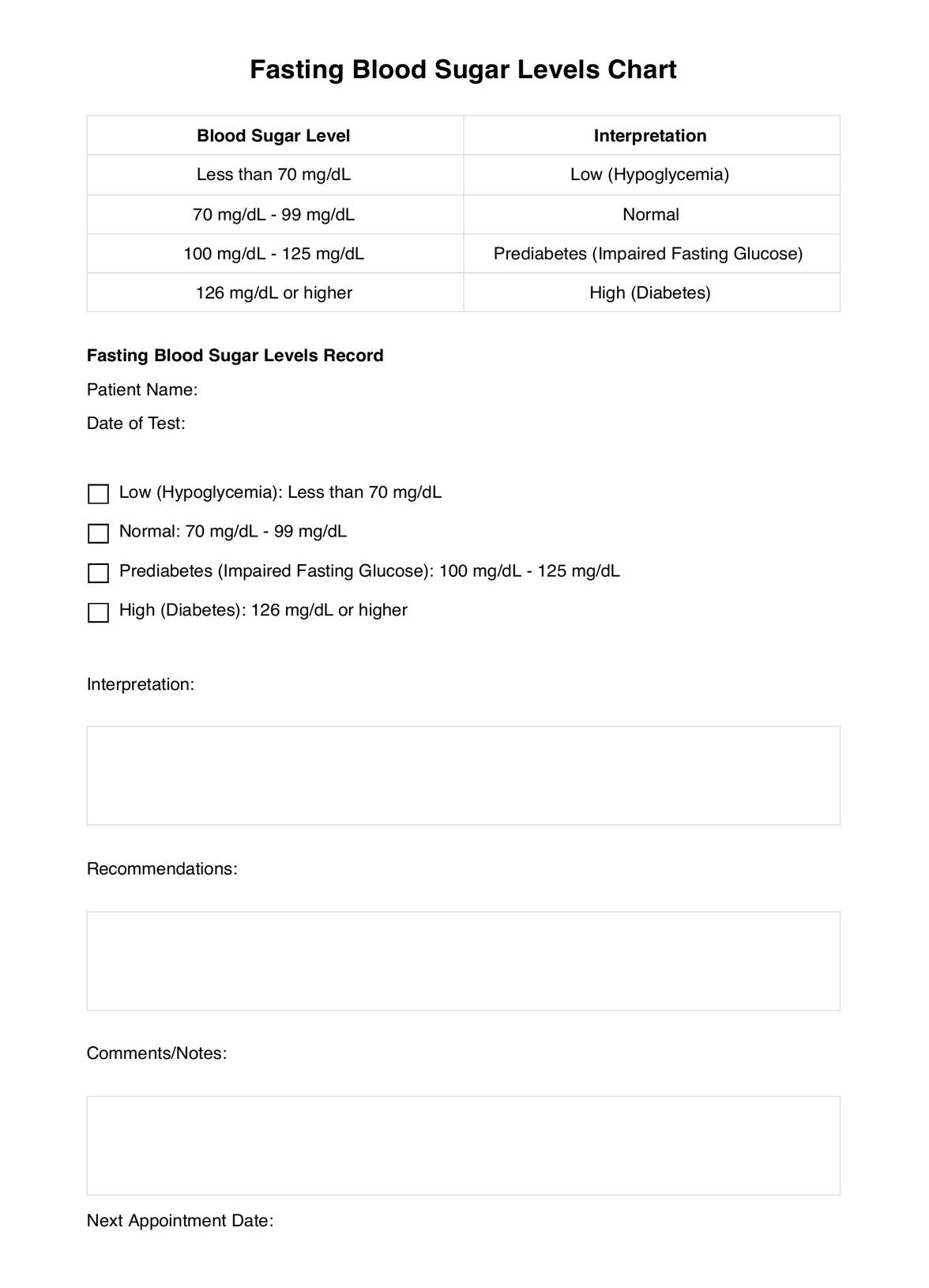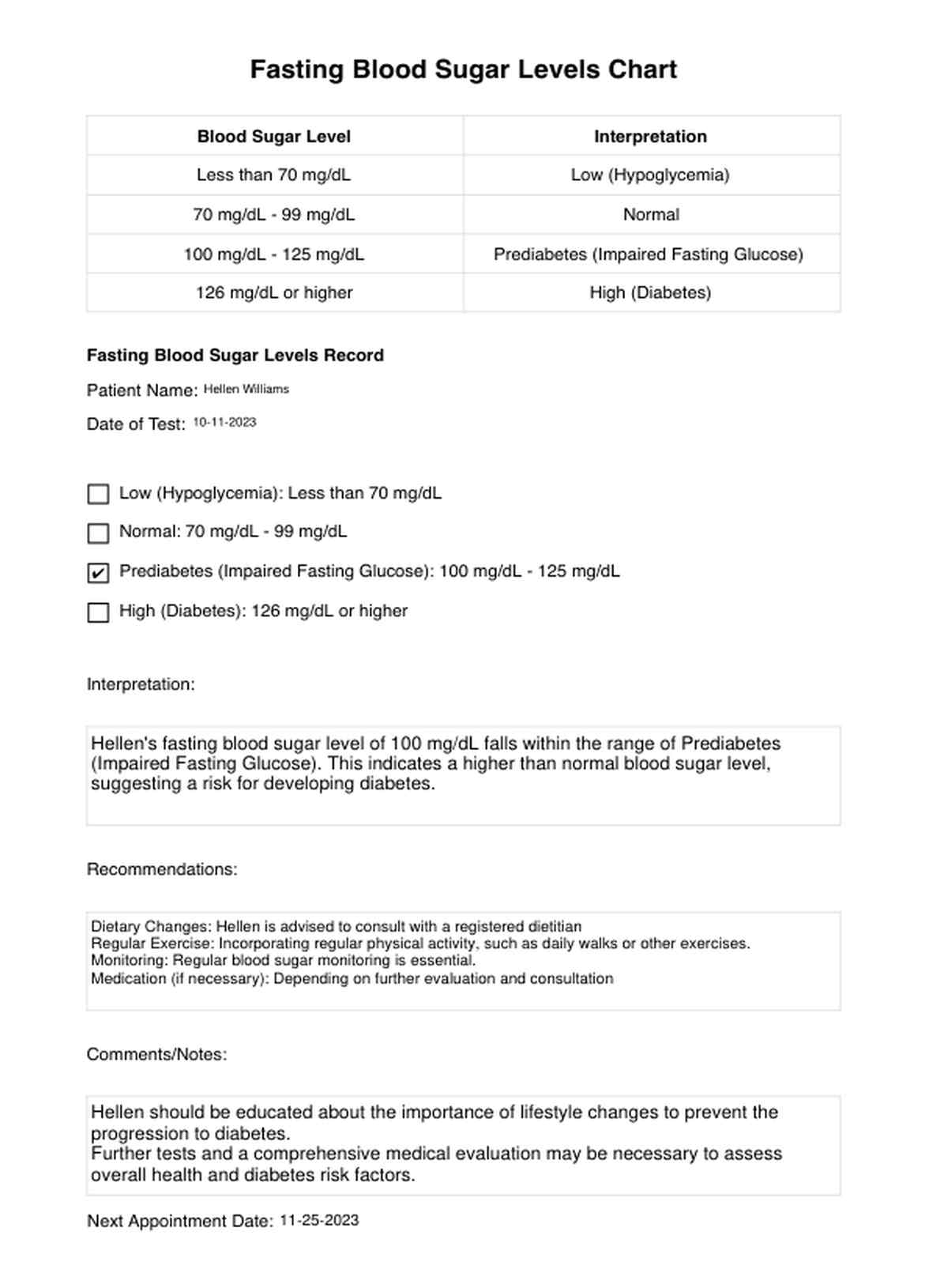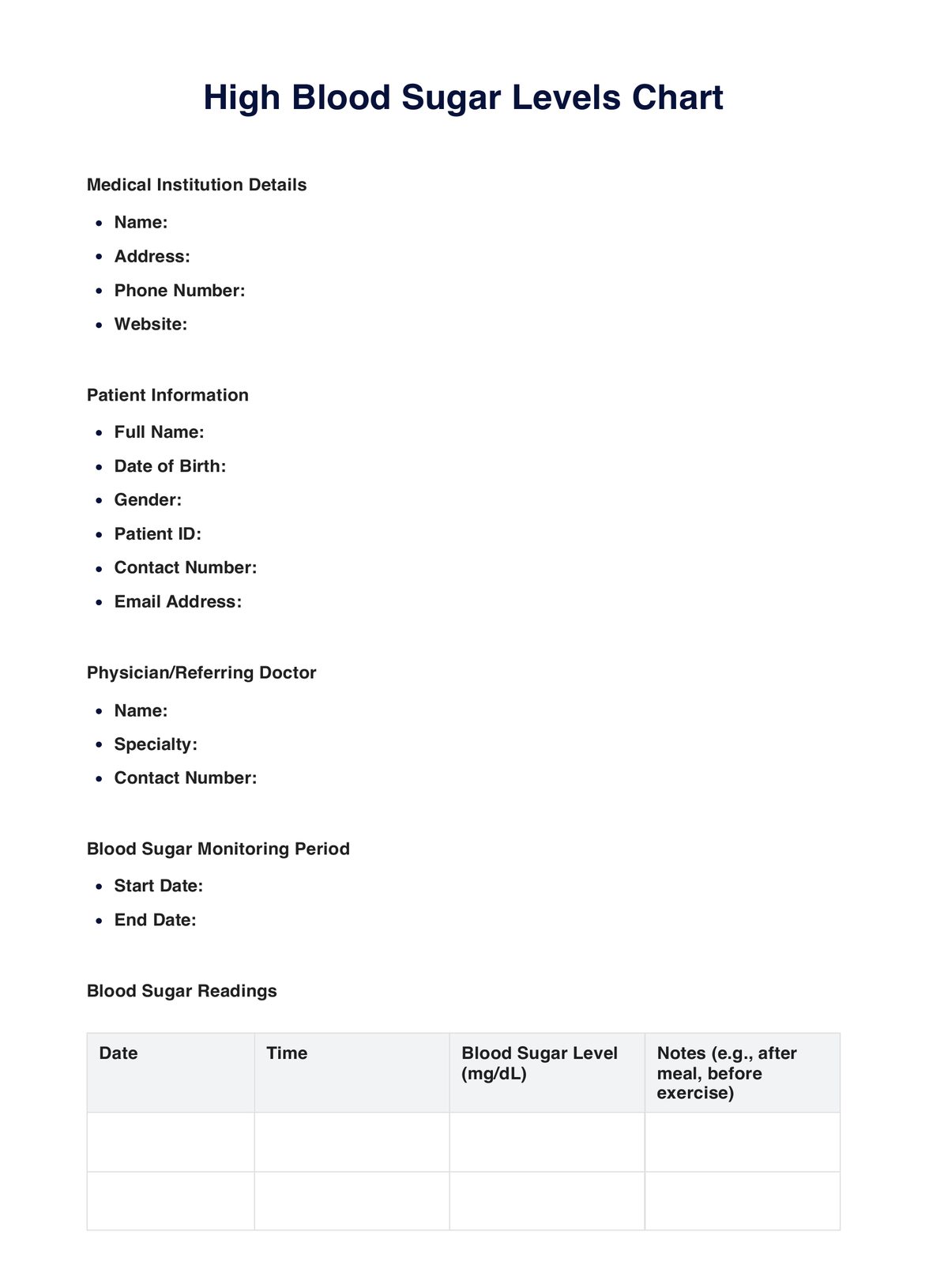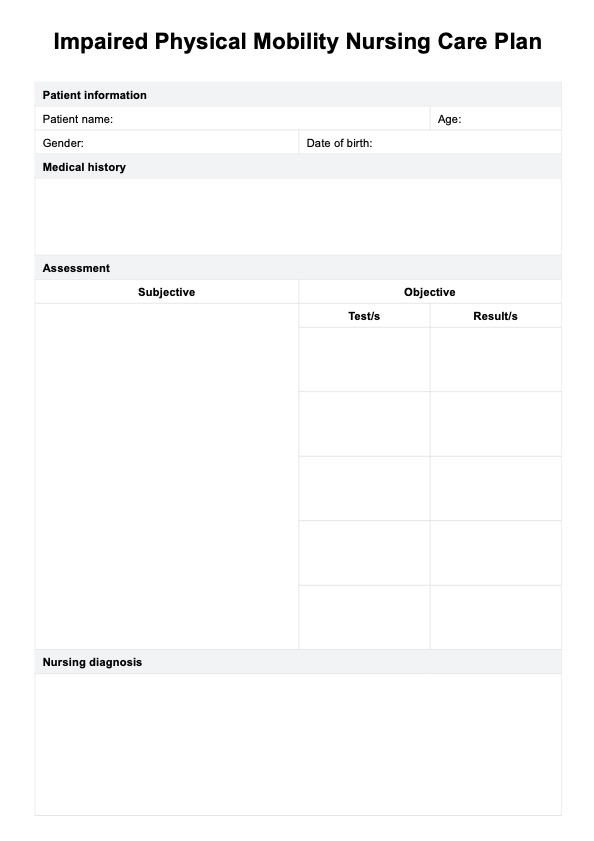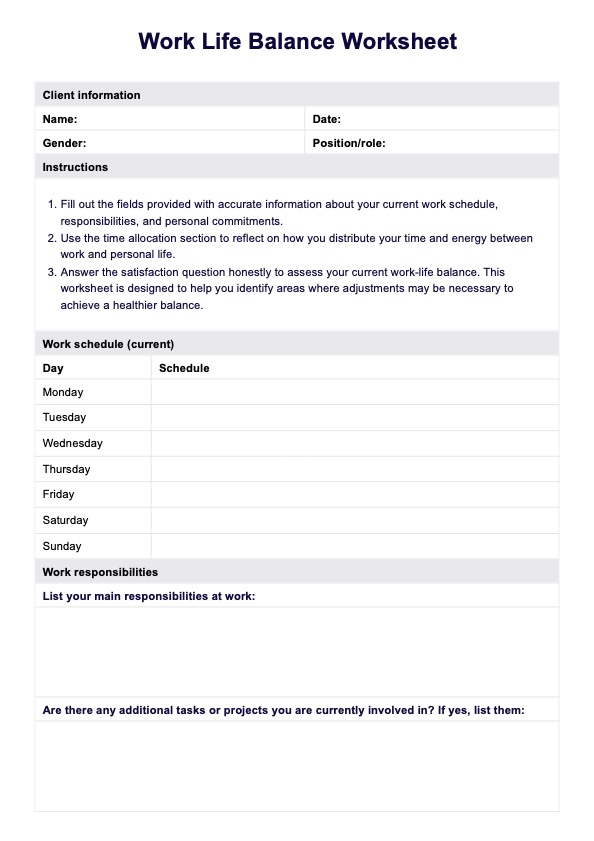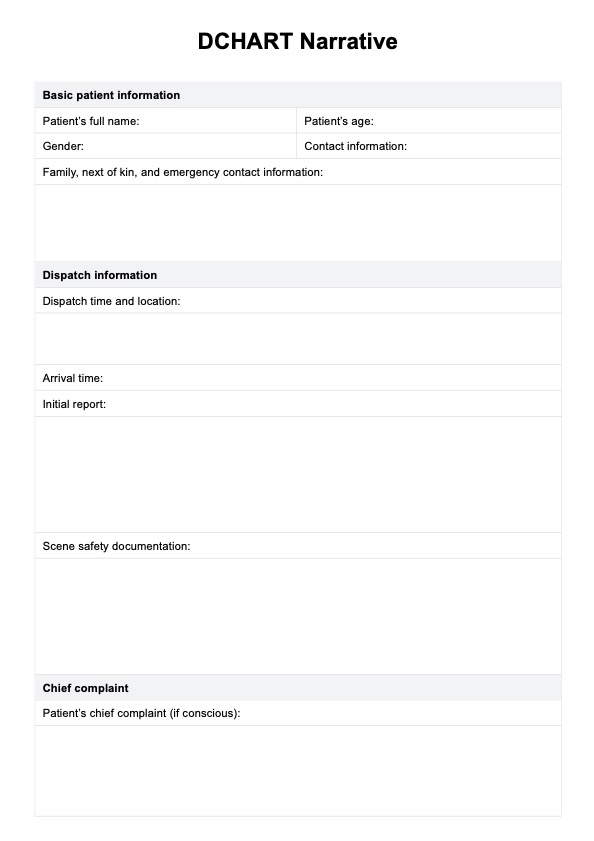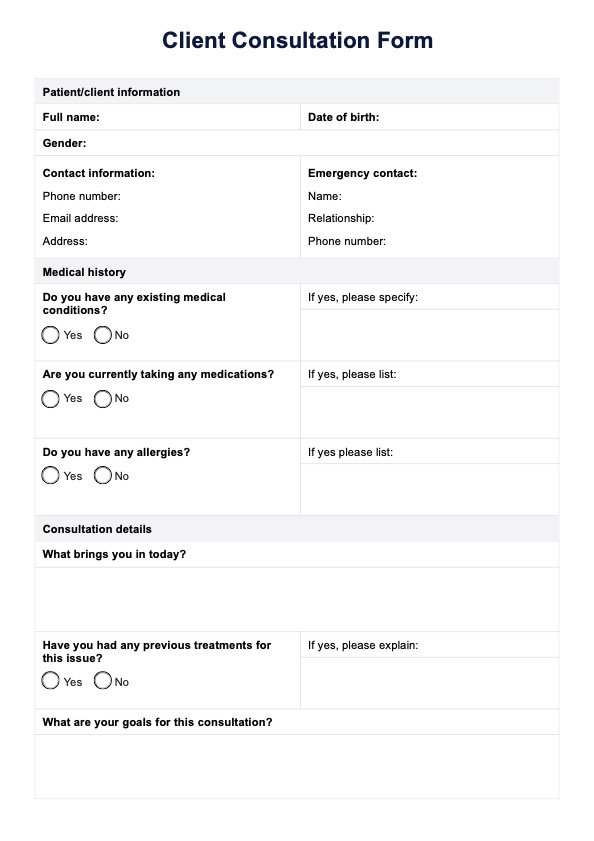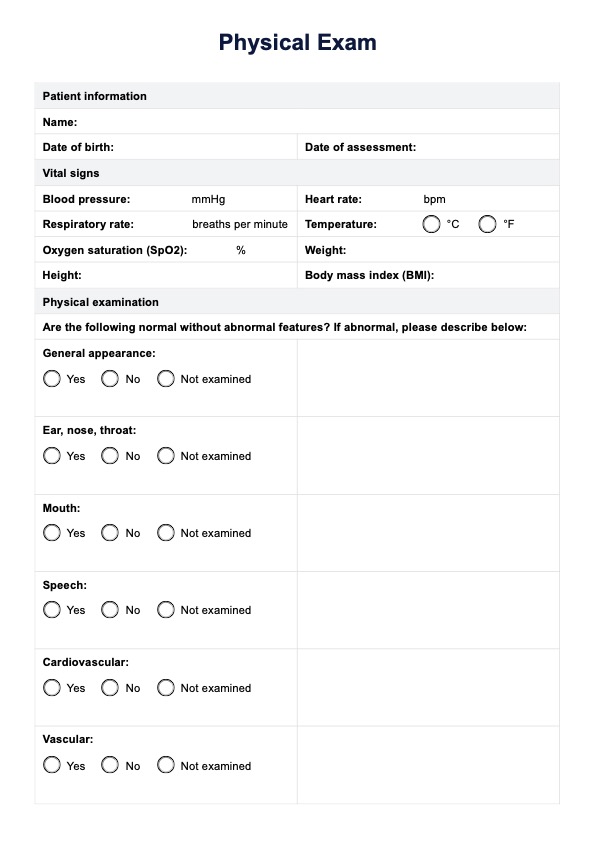Fasting Blood Sugar Levels
Use the Fasting Blood Sugar Levels Chart to monitor and control health. Understand blood sugar levels and make informed decisions.


What Is A Fasting Blood Sugar Levels Chart?
Fasting Blood Sugar Levels Charts are designed to assist individuals in understanding and monitoring their blood sugar readings. This chart is a visual guide, clearly interpreting blood sugar levels, typically measured after an overnight fast. It categorizes these levels into four distinct ranges: "Low (Hypoglycemia)," "Normal," "Prediabetes (Impaired Fasting Glucose)," and "High (Diabetes)."
The chart is essential for those concerned about their blood sugar health. The chart allows individuals to easily assess their fasting blood sugar levels and gain insights into their overall well-being. Understanding where their blood sugar falls within these ranges enables informed decision-making about potential lifestyle adjustments, dietary choices, or the need for medical attention.
Whether proactively managing one's health or managing a known condition like diabetes, the Fasting Blood Sugar Levels Chart provides a user-friendly reference point for tracking, interpreting, and responding to blood sugar fluctuations. It is a practical resource that empowers individuals to take charge of their health, helping them make informed choices to maintain or improve their overall health and well-being.
Fasting Blood Sugar Levels Chart
Fasting Blood Sugar Levels Chart Example
How Does it Work?
Step 1: Gather Necessary Information
Begin by obtaining a Printable Fasting Blood Sugar Levels Chart and ensure it contains essential patient details, including name and date of birth. Verify the test date, crucial for tracking the patient's blood sugar trends over time.
Step 2: Interpret the Results
Examine the patient's blood sugar reading in the chart. Interpret the value as "Low (Hypoglycemia)," "Normal," "Prediabetes (Impaired Fasting Glucose)," or "High (Diabetes)" based on the chart's guidelines. Understand the implications of each interpretation.
Step 3: Offer Recommendations
Provide recommendations based on the interpretation. For "Low (Hypoglycemia)," suggest steps to raise blood sugar levels. For "High (Diabetes)," advise immediate medical attention. For "Prediabetes," guide patients on lifestyle changes. Document these recommendations in the chart.
Step 4: Note Comments and Schedule Follow-Up
Use the Comments/Notes section to record relevant observations or patient information. Encourage the patient to schedule their next appointment and record the date for follow-up. The chart is a valuable tool for tracking blood sugar history and guiding patient care effectively.
When Would You Use This Chart?
The Fasting Blood Sugar Levels Chart is a versatile resource with broad applicability. It is used by individuals with diabetes for daily monitoring, helping them maintain their blood sugar within the target range. Healthcare providers often recommend it during routine check-ups, especially when diabetes or prediabetes is a concern.
Nutritionists and dietitians employ the chart to educate clients on the dietary impact on blood sugar, suggesting lifestyle changes accordingly. Endocrinologists utilize the chart to assess patient progress and treatment plans. Health educators use it in workshops focused on diabetes prevention and management, equipping attendees with a practical tool for self-monitoring.
The Fasting Blood Sugar Levels Chart is an essential resource in these contexts, fostering proactive health management, informed decision-making, and improved health outcomes.
What do the Results Mean?
Interpreting the results on a Free Fasting Blood Sugar Levels Chart is essential for understanding your blood sugar health. Common results fall into four categories:
Low (Hypoglycemia): This category indicates blood sugar levels below 70 mg/dL. It can lead to symptoms like dizziness and sweating, often requiring quick-acting carbohydrates.
Normal: Falling within 70 mg/dL to 99 mg/dL is considered normal, indicating healthy blood sugar levels and a lower risk of diabetes.
Prediabetes (Impaired Fasting Glucose): Results between 100 mg/dL and 125 mg/dL suggest an increased risk of developing diabetes, emphasizing the need for lifestyle changes.
High (Diabetes): 126 mg/dL or higher reading signifies diabetes. Immediate consultation with a healthcare professional is necessary to begin a suitable management plan.
Understanding these common results empowers individuals to assess their blood sugar health and take appropriate actions, whether it's a quick intervention for low blood sugar, maintaining healthy levels, or addressing prediabetes and diabetes through lifestyle changes and medical guidance. Regular monitoring is a valuable tool for long-term health management.
Research & Evidence
Fasting blood sugar levels are a critical measure of the glucose in your blood after an overnight fast of at least 8 hours. Glucose is the primary energy source for your body's cells and tissues, sourced from the food you consume. After eating, blood sugar levels rise, and insulin, a hormone, is released to help cells absorb glucose. Elevated blood sugar levels over time can damage blood vessels and nerves, resulting in serious health issues like heart disease, stroke, blindness, and kidney disease.
Extensive research has explored the implications of fasting blood sugar levels on health. Studies have revealed that individuals with prediabetes, characterized by higher-than-normal but not diabetic blood sugar levels, are at increased risk for developing type 2 diabetes, heart disease, and stroke. Those with type 2 diabetes face a higher risk of heart disease-related mortality.
To manage fasting blood sugar levels effectively, adopting a healthy diet rich in fruits, vegetables, and whole grains while limiting processed foods, sugary drinks, and unhealthy fats is vital. Regular exercise, at least 30 minutes of moderate-intensity activity most days of the week, enhances glucose utilization. Maintaining a healthy weight is also crucial, as excess weight elevates diabetes and chronic disease risks.
References
- Association Between Fasting Blood Glucose and All-Cause Mortality in a Rural Chinese Population: 15-Year Follow-Up Cohort Study (2021) by Xu et al., published in Diabetes Therapy
- Correlation of fasting and postprandial plasma glucose with HbA1c in assessing glycemic control; systematic review and meta-analysis (2015) by Shrestha et al., published in Archives of Public Health
- Fasting with diabetes: a prospective observational study (2020) by Yau et al., published in BMJ Global Health
- Diabetes: Diagnosis and Treatment (2023), published by the Mayo Clinic
Commonly asked questions
These are typically requested by healthcare providers, including doctors and nurses, for patients who need to monitor and manage their blood sugar levels, especially those with diabetes.
The charts are used when individuals need to track their blood sugar levels regularly. They are particularly valuable in managing diabetes, making dietary adjustments, or assessing overall health.
These are used by recording daily fasting blood sugar readings, interpreting the results, and implementing necessary actions, such as adjusting diet or medication, as guided by healthcare professionals.


